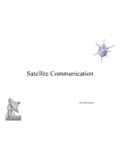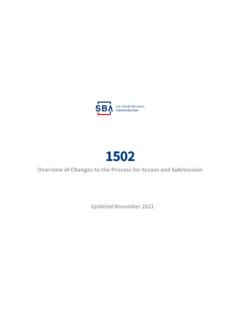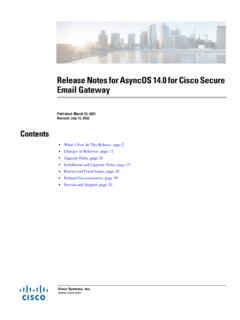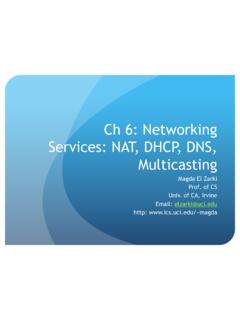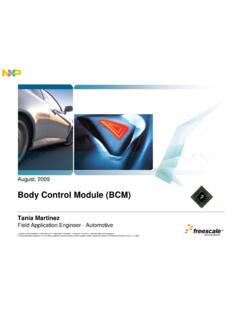Transcription of High Level Design 1.0 - University of British Columbia
1 1 High Level DesignDistributed Network Traffic ControllerRevision Number: date of revision: 2/2/0522c:198 Johnson, Chadwick HughChange RecordRevisionDateAuthorChangesHIGH Level DESIGNR evision: Date: 2/2/20052 Contents1. Why this High Level Design Document? Overview2. General Product Tools General Special Design aspects3. Design Main Design Application Technology Web Application Presentation Data Access Tools Database User Error Application Resource Major ClassesHIGH Level DESIGNR evision: Date: 2/2/200531.
2 Why this High Level Design Document?The purpose of this High Level Design (HLD) Document is to add the necessary detail tothe current project description to represent a suitable model for coding. This document isalso intended to help detect contradictions prior to coding, and can be used as a referencemanual for how the modules interact at a high ScopeThe HLD documentation presents the structure of the system, such as the databasearchitecture, application architecture (layers), application flow (Navigation), andtechnology architecture. The HLD uses non-technical to mildly-technical terms whichshould be understandable to the administrators of the Definitions DNTC Distributed Network Traffic Controller Fair Share An administratively set data rate per time frame that is considered fair.
3 Throttling A reduction in maximum transfer rate of data. Open Pipe A connection to the Internet with no throttling. Slow Pipe A throttled version of an open pipe where all users of that gateway sharethat reduced pipe s rate. Firewall Functionality that can allow or block certain ports and addresses. IPTables A firewall built into the Linux kernel. IPForwarding / IPMasquerading The ability to forward traffic. Postgres SQL Server A database management system. Python A possible programming language to interface between IPTables andPostgres. JDBC A possible Java-based interface between IPTables and the Database.
4 JSP The language that will be used for displaying user history and administrativefunctionality. Tomcat a free, open-source implementation of Java Servlet and JavaServer Pagestechnologies developed under the Jakarta project at the Apache Software Foundation. Apache - An open source Web server. ER Entity Relation Diagram CBQ Class-Based Queuing. Limits bandwidth at the IP/port Level . Kernel Core of an operating system, a kernel manages the machine s hardwareresources (including the processor and the memory), and provides and controls theway any other software component can access these resources.
5 DHCP (Dynamic Host Configuration Protocol) This is a protocol that letsnetwork administrators centrally manage and automate the assignment of IPAddresses on the corporate network. Gateway Bridges the gap between the internet and a local Level DESIGNR evision: Date: 2/2 OverviewThe HLD will: present all of the Design aspects and define them in detail describe the user interface being implemented describe the hardware and software interfaces describe the performance requirements include Design features and the architecture of the project list and describe the non-functional attributes like:o securityo reliabilityo maintainabilityo portabilityo reusabilityo application compatibilityo resource utilizationo serviceability2.
6 General Product Perspective The Distributed Network Traffic Controller will be comprised of several differentcomponents. Some of these components will be programmed, while others will beimplementations of open-source programs. The language implemented will be dictated byit s purpose. The administrative and user interfaces will be using JSP to display the pages,and SQL to retrieve, insert, delete, and update the database. Either Python or JDBC will beused to submit SQL commands for the automated part of the project such as updating theuser history and DHCP data. This setup will allow for multiple users to login and interactwith the program at the same time.
7 It will also be set up using two user levels. First is thebasic user, which can only view their current average and their history. This page isautomatically displayed based on their IP address. The second type of user is theAdministrator. They have the ability to change information in the database such as settingsand user history. This user Level can only be attained by logging into the Tools used1. Jude, a Java based UML Design program, is used to generate all of the diagramsused in analysis and Design phases of the The project will have a relational database backend that is SQL based.
8 The actualsoftware used is Interfacing with the database to display information on the user s web browserwill be done using JSP. It can connect to the database and parse it into viewableHTML Tomcat compiles JSP pages into servlets to be displayed through Apache - An open source web server that will display requested Level DESIGNR evision: Date: 2/2/200556. Automated interfacing with the database behind the scenes will be either Pythonor DHCP assigns IP CBQ is a throttling mechanism based on After a Kernel recompile, IPTables allows for IPMasquerading. IPTables alsoacts as a built in RedHat Fedora Core 2 is the development General ConstraintsThe Distributed Network Traffic Controller must be user friendly and as automated aspossible.
9 Administrators should not be required to do anything besides the initial setup,and users should not be required to know any of the workings. Without logging in, theuser will only have the ability to view that IP s current average and history. Afterlogging in, that user then has the ability to change settings and user AssumptionsThis project is based on the idea of a Fair Share, and the goal is to make this idea a realityusing Software Engineering practices. In doing so, many documents are created, and it isassumed that Design flaws will be found early on. It is also assumed that all aspects ofthis project have the ability to work together in the way the designer is assumption is that the current intended documentation will suffice to make thisproject count towards the Software Engineering Subtract.
10 There is also an assumptionthat none of the work or hardware will be stolen or sabotaged. The final assumption isthat a demonstration and presentation will be possible at the end of the Special Design aspectsOne special Design aspect is the understanding that without significant modification, thissystem will only work on IP based traffic. This means TCP and UDP will be counted,but it is not known how any other type of traffic will be handled by this Design Main Design FeaturesThe main Design features include five major parts: the architecture, the user interfacedesign, external interface, the database, process relation, and automation.

